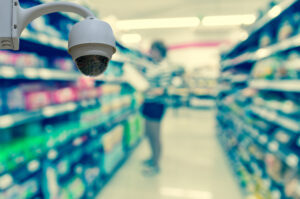Device Location is the Solution for Reducing Loss in Mobile Self-Checkout
At its onset, Mobile Self-Checkout (also known as Scan & Go, Scan & Bag, Scan Pay Go, etc.) services showed tremendous promise. Touted as a technology that would revolutionize the retail industry, the service was destined to improve the shopper experience, and at the same time free up store resources.
According to GPShopper, 48% of US internet users believed that Scan & Go would make shopping easier and 43% said they would rather use the new technology instead of waiting at the checkout line.
THE PROBLEM
Unfortunately, cracks began to form using Scan & Go and major retailers decided to abandon ship. Both Wegmans and Hy-Vee have dropped the service in the last year citing high losses.
Potential losses from the service can be significant and are primarily caused by misscans, both intentional (shoplifting) and unintentional (human error). According to a study conducted by the University of Leicester, product loss could go up an extra 1% to 10% per store using Scan & Go.
Of course, bumps in the Scan & Go road will be hard for consumers already reliant on the solution. More independence and more time saved – why would a shopper want to lose this game-changing service? It also proved to be a reason why shoppers remain loyal to certain retailers, so there’s mutual interest on top of the operational benefits.
In order for Scan & Go to succeed, retailers must find a way to maximize the service’s potential while minimizing losses.

Supermarket security camera
CURRENT APPROACHES
Currently, retailers employ different methods for alerting and flagging missed scans by shoppers. Randomized cart checks, exit gates, and rules for flagging people that have had issues in the past, first-time users, or heavy carts are all tools within the retailer’s arsenal. The issue is that these methods are not effective enough, take a toll on store security and resources, and don’t actually deter shoppers from theft or making mistakes. These approaches are not vigilant enough to prevent retail shrinkage.
NOW: ADDING SHOPPER LOCATION TO THE MIX
There is still hope for Scan & Go. If retailers could track shoppers in real-time walking through the store, then they could add advanced logic to the shopper journey and make fraud detection more reliable.
The primary issue is that indoor location is difficult to provide. With GPS services not being able to penetrate buildings, retailers need to turn to costly, maintenance-heavy, and less accurate Wi-Fi and Bluetooth options.
THE SOLUTION
Oriient is a software-only in-store location service provider. Implementing directly into retailer apps, Oriient only uses the existing sensors in the user’s smartphone, or handheld scanning device, to function, and is highly accurate (1m/3ft). This means fast-paced scalability and zero maintenance.
By knowing exactly where the shopper is throughout their store journey, retailers can think outside of the box to prevent intentional and unintentional retail shrinkage.

A shopper’s product-scan is tagged with a location
From the retailers perspective, store operators can now:
- Track abnormal shopping behaviors (scanning items outside of their designated section), shopper lingering tendencies (spending time in areas without scanning items), and even suspicious journeys that counter natural shopper flows.
- Put specific alerts on areas more prone to scanning errors.
- Run A/B testing on specific stores to create a tailored solution for their specific shoppers and better identify which shoppers should be audited at the end of their shopping journeys.
For shoppers, they can now receive alerts and friendly reminders based on their location in the store. For example, shoppers can:
- Be reminded to scan their items if they linger for too long in certain areas or shop in aisles that often have misscans.
- Receive a push notification on their way to the checkout asking if they scanned all their items.
- Of course, users are aware and need to grant permission to enable location services. So potentially a shopper realizing the transactions are being watched is enough to increase attention to avoid misscanning.
For more advanced detection algorithms, a retailer can ask Oriient to provide Machine Learning models to identify baskets that have a higher probability of requiring additional checks, by learning the behavior in their own stores.
USING SCAN & GO WITHOUT FEAR
With Oriient, retailers no longer need to worry about retail shrinkage from Scan & Go services. This means that retailers can reduce losses and also limit other security measures, including the need for randomized or strategic basket checks. Oriient also allows shoppers the convenience of shopping based on their preferences and needs.
Applying Oriient IndoorGPS in a store also unlocks many more benefits that can easily be added to the app, such as navigation to products and proximity marketing – finally making Scan & Go apps profitable for retailers.
